Gluten-free fish and chips takes me back to childhood Friday nights—back when the scent of frying oil meant something good was happening. I remember sitting at the kitchen table, legs swinging under the chair, waiting for that first bite. Crispy golden batter, flaky fish inside, and salty chips steaming on the plate. Those were simple, happy times.
Fast forward to today, and things look a little different. Like many, I had to go gluten-free—not by choice, but by necessity. Giving up classic comfort food was tough at first, but I wasn’t about to let gluten ruin one of my favorite meals. That’s how this gluten-free fish and chips recipe was born—from determination, a lot of kitchen tests, and a craving for that nostalgic crunch.
If you’re avoiding gluten because of celiac disease, gluten sensitivity, or just want a cleaner way to enjoy fried food, this guide is for you. We’re going to explore how to recreate traditional fish and chips without a trace of wheat, using smart substitutions that keep all the flavor and texture you love. You’ll learn what ingredients to use, how to fry like a pro, and even how to make gluten-free fish and chips in an air fryer. No guesswork—just golden, crispy results every time.
Want dessert after dinner? Try our soft and decadent Gluten-Free Chocolate Cupcakes for a sweet finish to your fish fry night.
Let’s kick it off by exploring why you should consider going gluten-free—even for a dish as traditional as fish and chips.

Table of Contents
Table of Contents

Crispy Gluten-Free Fish and Chips
Ingredients
Equipment
Method
- Dry the Fish: Pat cod/haddock fillets dry using paper towels and slice into 2–3-inch strips.
- Dredge: Lightly coat the fish in rice flour, salt, and pepper.
- Mix the Batter: Whisk all dry ingredients, then add egg and slowly mix in gluten-free beer or soda until smooth.
- Prep Potatoes: Cut potatoes into thick sticks, soak in water for 30 minutes, then drain and pat dry.
- Parboil or Pre-fry Chips: Boil or fry at 300°F for 3–4 minutes, remove and rest on paper towels.
- Deep Fry Fish: Dip each fish strip into batter, let excess drip, and fry at 375°F until golden (about 3–4 minutes).
- Final Fry Chips: Raise oil to 375°F and fry chips until golden and crispy.
- Serve: Drain fish and chips on paper towels, sprinkle with sea salt, and serve with tartar sauce and lemon wedges.
Nutrition
Notes
- Keep everything the same size. Even cuts of fish and potatoes help cook everything evenly and make frying a breeze.
- Always remove the skin from your fish—it acts like a barrier that keeps the batter from sticking properly. Pat each piece dry to help your gluten-free coating cling.
- You can use any mild white fish like cod, haddock, or sea bass. Just make sure it’s boneless and skinless for best results.
- Gluten-free beer gives your batter a lift and rich flavor. Can’t find it? Club soda works great too and keeps things light.
- Set your oven to 200°F to keep fish warm while you finish frying in batches.
- Never skip the soak and double-fry for your chips. It helps make the inside soft and the outside perfectly crisp.
- To test if your oil is ready, drop in a bit of batter. If it sizzles quickly and floats, you’re good to go.
- Use a thermometer to keep oil steady between 350°F–375°F. This helps avoid greasy, undercooked results.
- Gluten-free fish and chips are best enjoyed fresh. But if needed, store leftovers separately in airtight containers and eat within 2 days.
Tried this recipe?
Let us know how it was!Why Go Gluten-Free with Fish and Chips?
Understanding Gluten Intolerance and Celiac Disease
Gluten-free fish and chips isn’t just a trendy spin—it’s a much-needed alternative for many people. Gluten, found in wheat, rye, and barley, can cause serious health issues for those with celiac disease or gluten sensitivity. Even a small amount can trigger digestive problems, headaches, or fatigue.
Traditional fish and chips are loaded with gluten. From the wheat-based batter to the shared fryer oil, this classic dish is typically off-limits. That’s why making gluten-free fish and chips at home isn’t just convenient—it’s essential. You get full control over the ingredients, the cooking oil, and how it’s all prepared.
And here’s the surprise: once you taste crispy, golden fish made with gluten-free flour and bubbly batter, you may never want to go back. The lighter texture and bold flavor are hard to beat.
Benefits of a Gluten-Free Diet Beyond Medical Needs
You don’t need a diagnosis to benefit from a gluten-free lifestyle. Many people report better digestion, reduced bloating, and even clearer skin after switching to gluten-free meals. And when you make something like gluten-free fish and chips, you realize that comfort food can be both satisfying and easy on your gut.
If you’re new to gluten-free living, check out our Gluten-Free Biscuits and Gravy—it’s another hearty classic done right without the gluten.
This dish is also a great introduction for families or first-timers. It’s approachable, familiar, and tastes just as indulgent as the original—if not better. Gluten-free flour blends, rice flour, and even gluten-free beer create a batter that’s extra crisp and flavorful.
Ingredients That Make the Best Gluten-Free Fish and Chips
Best White Fish Options: Cod, Haddock, and Beyond
The soul of gluten-free fish and chips starts with the fish itself. You want something light, flaky, and mild—nothing too oily or fishy. Traditionally, cod and haddock are the go-to choices. They’re firm enough to hold up to frying but tender enough to flake beautifully with a fork.
If you can’t find those, pollock, halibut, or even sea bass are great stand-ins. Just make sure your fillets are evenly cut and skinless—skin can prevent the batter from sticking. Also, dry the fish well with paper towels before dredging. A dry surface helps the gluten-free batter cling better and fry up extra crisp.
Choosing the Right Potatoes for Crispy Chips
Now let’s talk chips—because no gluten-free fish and chips meal is complete without them. The best potatoes for homemade chips are Russets. They’re starchy, dense, and fry up golden and fluffy on the inside while getting perfectly crispy on the outside.
Before frying, you’ll want to cut your potatoes into even sticks—about ½ to ¾ inch thick. Then, soak or parboil them. This crucial step removes excess starch and pre-cooks the interior so you don’t end up with raw centers. Fry once at a lower temp to soften, then again at high heat for that irresistible crunch.
Want a classic gluten-free brunch idea? Try our Gluten-Free Popover Mix—fluffy, crisp, and perfect with eggs or gravy.
Exploring Gluten-Free Flour Alternatives for Frying
Here’s where the magic really happens. The right flour mix is what turns a regular meal into mouthwatering gluten-free fish and chips. Traditional recipes use wheat flour, but we’re going better—lighter, crispier, and 100% gluten-free.
Here are top gluten-free flour choices:
| Gluten-Free Flour | Best For | Texture Result |
|---|---|---|
| Rice Flour | Dredging & Batter | Light and crunchy |
| Gluten-Free All-Purpose Blend | Batter | Crisp with structure |
| Cornstarch (small amount) | Batter enhancer | Extra crisp finish |
| Chickpea Flour (optional) | Flavor depth | Nutty and rich |
| Potato Starch | Batter boost | Extra airy and golden |
You can also mix in gluten-free beer or club soda. Both add carbonation, making the batter bubble up into that signature airy crispiness.
How to Make Gluten-Free Battered Fish at Home
Step-by-Step Prep for the Fish: Drying, Dredging, and Battering
If there’s one secret to getting gluten-free fish and chips just right, it’s all in the preparation. You can’t rush this part—well-prepped fish leads to that iconic golden crisp that everyone loves.
Step 1: Dry the Fish Thoroughly
Start with boneless white fish fillets like cod or haddock. Cut them into even 2- to 3-inch strips. Then, take paper towels and press gently on each piece to remove surface moisture. This is crucial—wet fish leads to soggy batter.
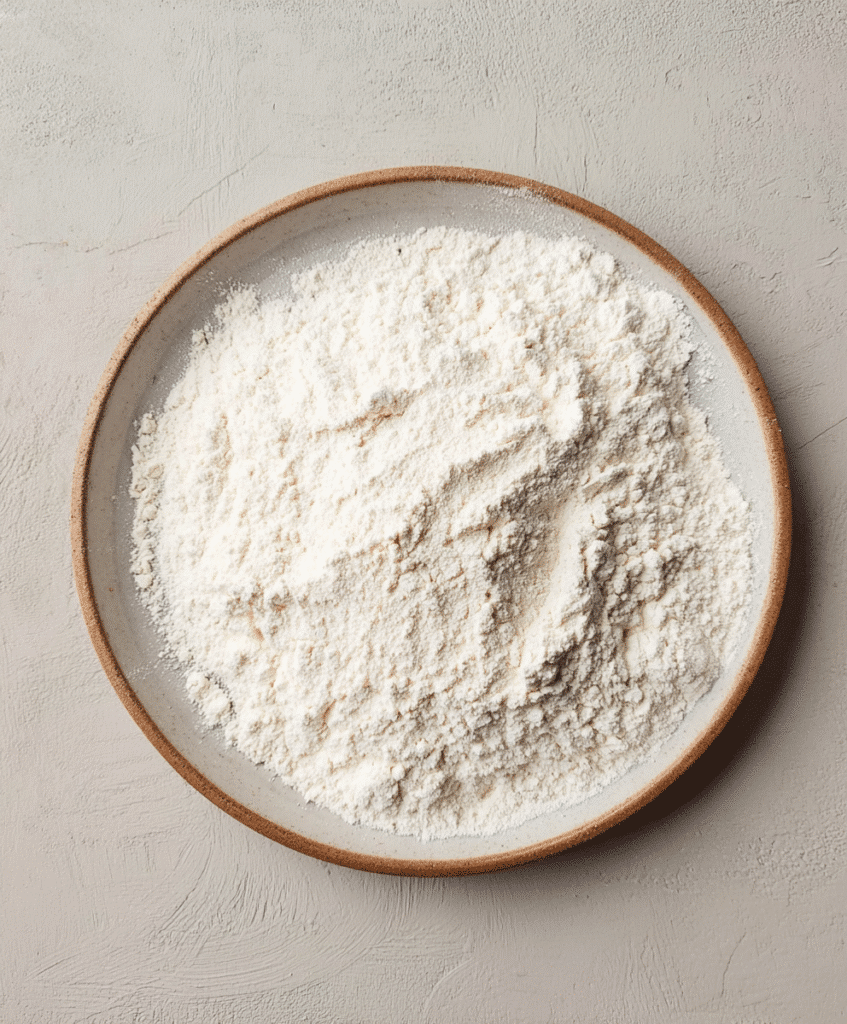
Step 2: Dredge Before You Batter
In a shallow bowl, mix ¼ cup rice flour with salt and black pepper. Lightly coat each fish strip in this dry mixture. This helps the batter stick and creates an extra-crunchy outer layer once fried.
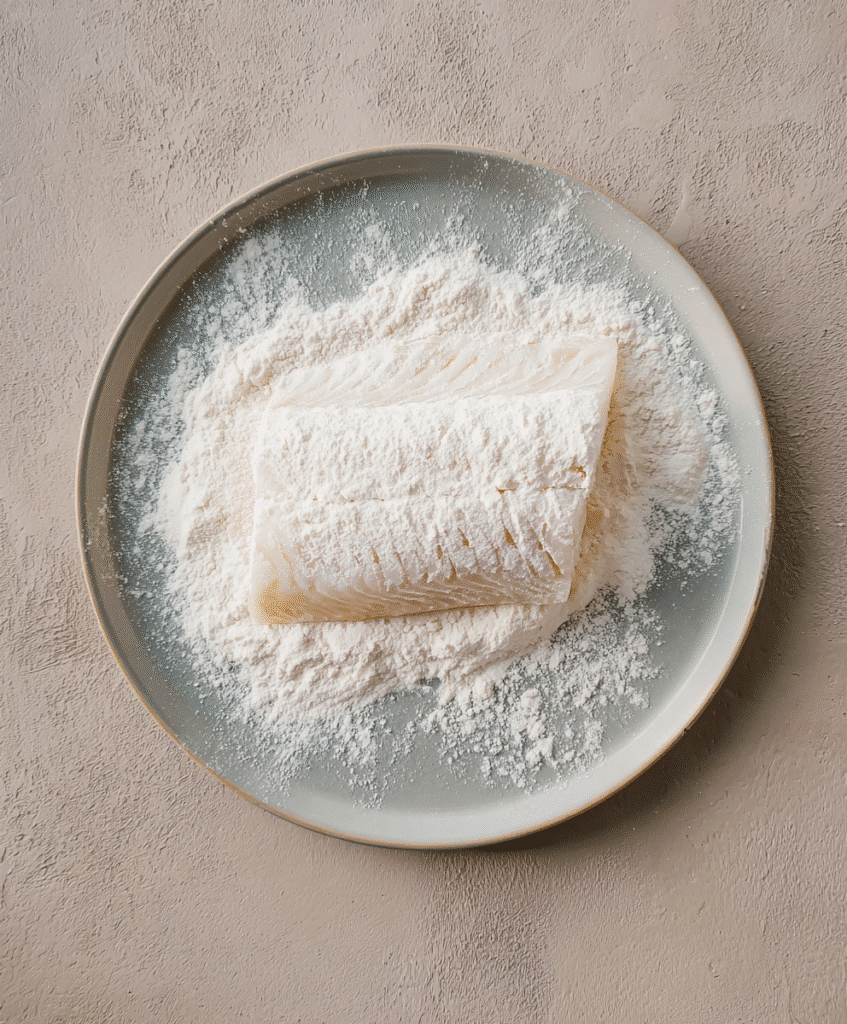
Step 3: Dip in Batter Right Before Frying
After dredging, it’s time to dip the fish into your gluten-free batter. Make sure the fish is fully coated, then let the excess drip off before gently lowering it into the hot oil. Always fry in small batches to keep the oil temperature steady.
If you’re looking for comfort food that’s just as satisfying as your childhood favorites, gluten-free fish and chips is the meal to master.
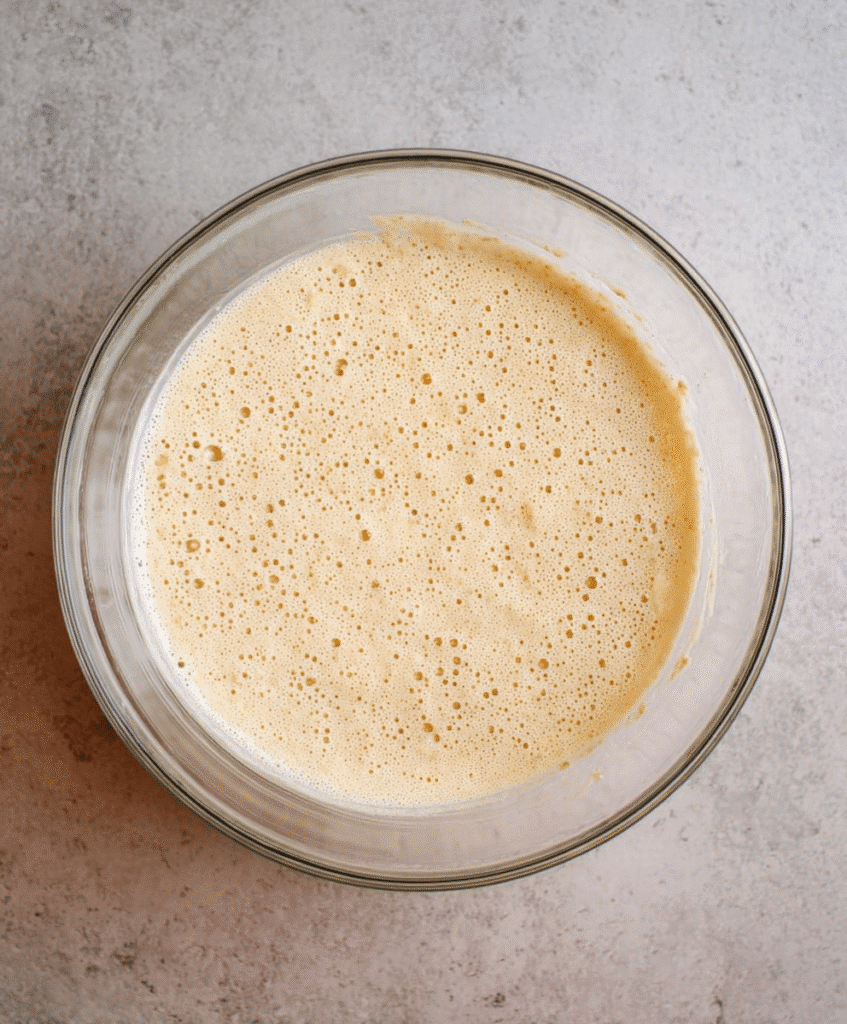
How to Mix the Perfect Gluten-Free Batter (Club Soda)
Let’s talk about the magic mix behind every crispy bite. A great batter makes or breaks your gluten-free fish and chips, and the secret is in the fizz.
Ingredients You’ll Need:
- 1 cup gluten-free all-purpose flour
- ¼ cup white rice flour
- 1 tsp baking powder
- ½ tsp each: salt, garlic powder, onion powder, Old Bay, paprika, black pepper
- 1 egg
- 12 oz gluten-free club soda
How to Make It:
Whisk the dry ingredients first. Then beat in the egg and pour in the beer (or club soda) gradually until you get a smooth, slightly thick batter. Let it sit for 5 minutes to activate the bubbles.
Why It Works:
The carbonation makes the batter light and airy, while the flours keep it crispy. Gluten-free beer adds a nice depth of flavor that enhances the fish without overpowering it.
Cooking Techniques for Restaurant-Level Results
The Art of Double-Frying Chips: Parboiling to Golden Crisp
When making gluten-free fish and chips at home, nailing the chip texture is just as important as perfecting the fish. That’s where double-frying comes in.
Step 1: Parboil the Potatoes
Start by cutting Russet potatoes into ½ to ¾ inch sticks. Soak them in water, then bring the water to a boil with the potatoes inside. Once boiling, turn off the heat and let them sit for 30 minutes. This par-cooks the centers, helping them stay soft inside after frying.
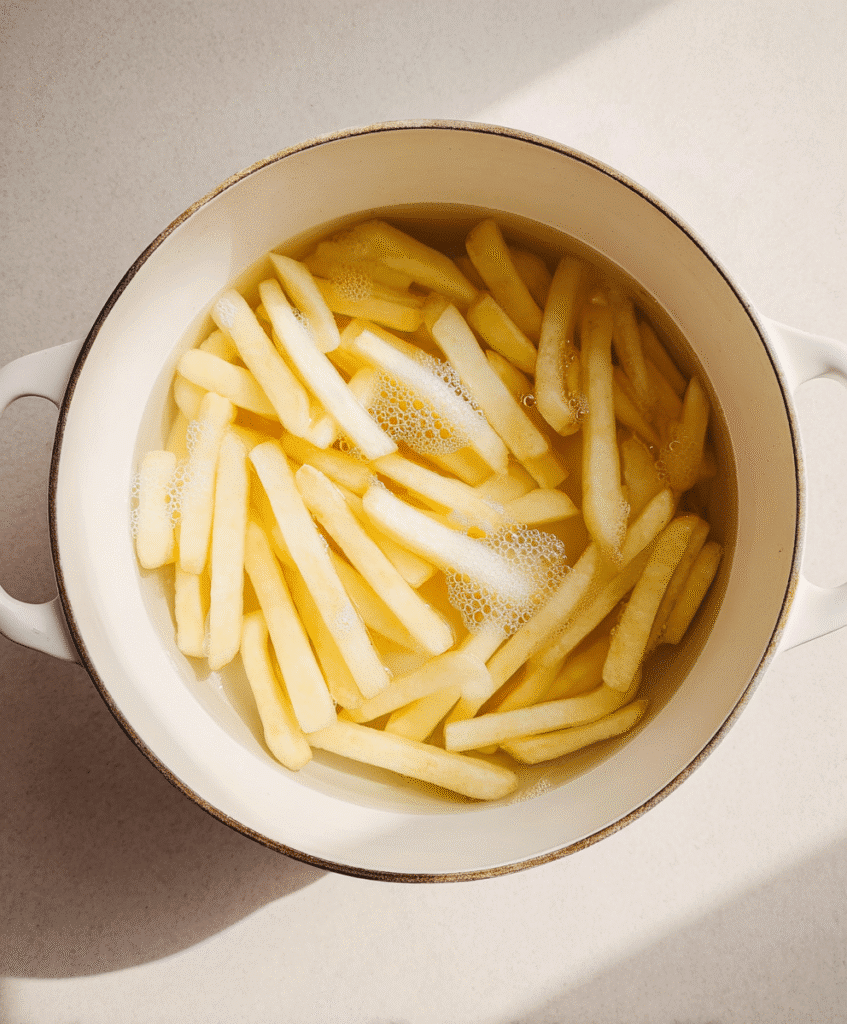
Step 2: First Fry (Low Temp)
After draining and drying the potatoes thoroughly, fry them at 300°F for about 3–5 minutes. This first fry cooks them through without browning. Remove and set them aside on paper towels to drain.
Step 3: Second Fry (High Temp)
Now crank the oil up to 375°F. Fry the chips again, this time for 1–3 minutes until they’re golden and crispy on the outside. Sprinkle with sea salt right after removing them from the oil.
These fries are the ideal partner to gluten-free fish and chips, giving you that crispy-soft contrast every good plate needs.
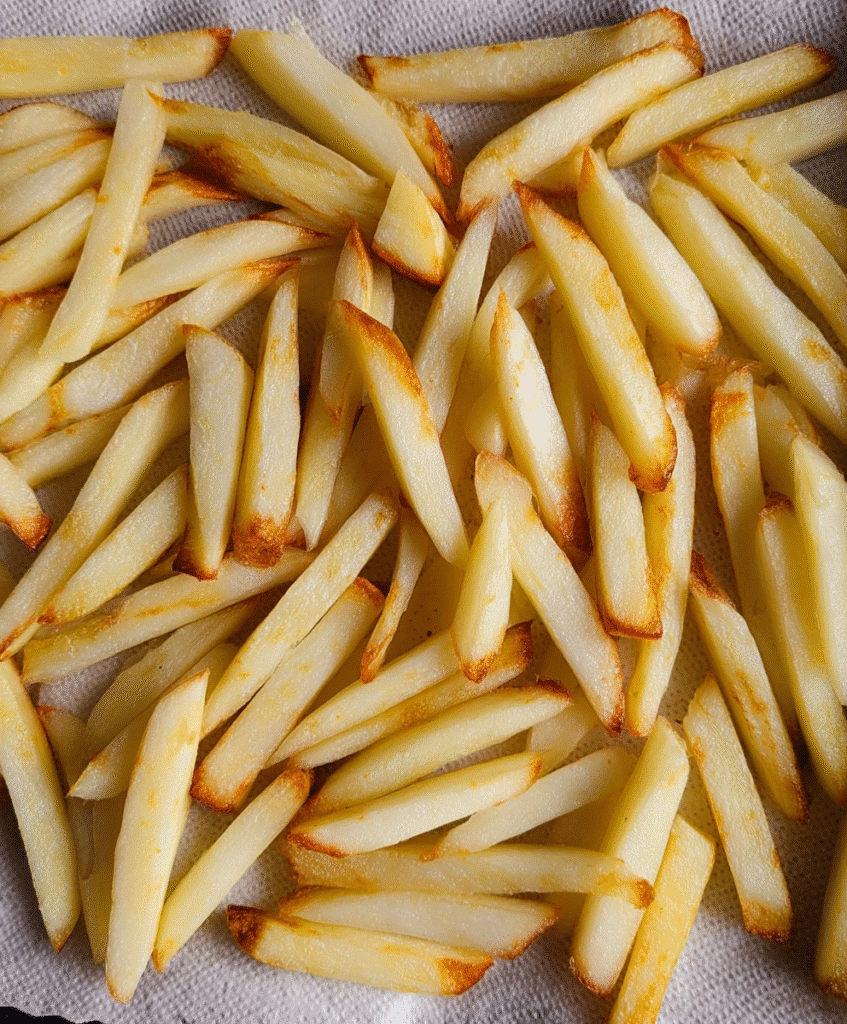
Maintaining Oil Temperature for Crispy, Non-Greasy Fish
Temperature control is everything in frying. Let it drop too low, and your gluten-free fish and chips will soak up oil like a sponge. Too hot, and the outside burns before the inside cooks.
Ideal Frying Temperature:
- Start at 375°F before adding the fish. Once it hits the oil, the temp will drop to around 350°F, which is right where you want it.
- Use a deep-fry or candy thermometer to monitor the heat. It’s a small tool that makes a big difference.
Batch Cooking:
Never overcrowd the pot. Fry 2–3 pieces at a time max. Crowding lowers the oil temp and results in soggy batter. Give each piece room to crisp.
Tip: Keep finished pieces warm in a 200°F oven on a wire rack. This keeps everything crispy until it’s time to serve.
Gluten-Free Air Fryer Fish and Chips
Modifying the Recipe for Air Frying: What You Need to Know
If deep frying feels like too much work (or mess), you’ll love this twist. Making gluten-free fish and chips in the air fryer is not only faster—it’s cleaner, less oily, and still delivers serious crunch.
The biggest change is in the batter. Traditional beer batter is too wet for most air fryer baskets. So, for best results, you’ll want a thicker batter or a panko-style coating using gluten-free breadcrumbs.
Here’s a modified air fryer-friendly approach:
- Dredge your fish as usual in rice flour, salt, and pepper.
- Dip it in a slightly thicker version of your gluten-free batter (reduce the liquid slightly).
- Press the coated fish into gluten-free breadcrumbs for extra crunch (optional but recommended).
- Spray both sides lightly with oil. This step is key for getting golden results in the air fryer.
Line the basket with parchment paper or spray it to prevent sticking. Cook in single layers only—no overlapping.

Air Fryer Timing and Temperature Guide for Perfect Texture
Here’s a quick reference table to guide you through air frying gluten-free fish and chips:
| Item | Temp | Time | Tips |
|---|---|---|---|
| Fish Fillets | 400°F | 8–12 min | Flip halfway through, spray again |
| Potato Chips | 375°F | 15–20 min | Shake every 5 mins, small batches |
For fish: You’ll know it’s done when the coating is golden and crispy, and the internal temperature reaches 130°F–135°F. Use a food thermometer to be sure.
For chips: Toss sliced Russet potatoes in a touch of oil and sea salt. Cook in small batches so each piece gets proper air circulation.
Why the Air Fryer Version Still Hits the Spot
Air fryer gluten-free fish and chips might be lighter, but they don’t sacrifice flavor. The fish stays juicy, the crust crisps up beautifully, and the chips are golden with just a touch of oil.
Bonus? You avoid hot oil splatter, the cleanup is easy, and your kitchen doesn’t smell like a deep fryer all day. It’s a win on every front.
What to Serve with Gluten-Free Fish and Chips
Tartar Sauce, Slaw, and Lemon: Traditional Pairings
When you’ve just pulled a batch of hot, crispy gluten-free fish and chips from the fryer or air fryer, don’t stop there. The right side dish or sauce can turn a great meal into a memorable one.
Tartar sauce is a classic. Its tangy richness cuts through the crunch of fried fish like a dream. Make your own by mixing mayonnaise, chopped pickles, lemon juice, and a pinch of dill. Want extra zing? Add a dash of Dijon mustard.
Fresh lemon wedges are essential. Squeeze one over the fish just before digging in—it brightens every bite.
And don’t forget coleslaw. Creamy slaw adds a cool, crunchy contrast to the warm, golden batter of your gluten-free fish and chips. Whether you prefer mayo-based or vinegar-style slaw, it’s a perfect pairing.
Creative Side Dishes and Dips for a Flavor Twist
Want to give your plate a little extra personality? Try pairing your gluten-free fish and chips with one of these creative sides:
- Avocado slaw with lime for a California twist
- Sweet potato fries for a slightly sweet, crispy variation
- Roasted garlic aioli as a bold dipping sauce
- Pea purée, a British classic with a modern spin
- Cucumber salad with dill and apple cider vinegar for something cool and light
For drinks, consider something bubbly and refreshing. A citrus spritzer, ginger beer, or a light cider pairs beautifully with the salt and crunch of fried fish.
Want something bolder? Serve it with a side of Gluten-Free Chicken Tenders for a full-on gluten-free pub-style platter.
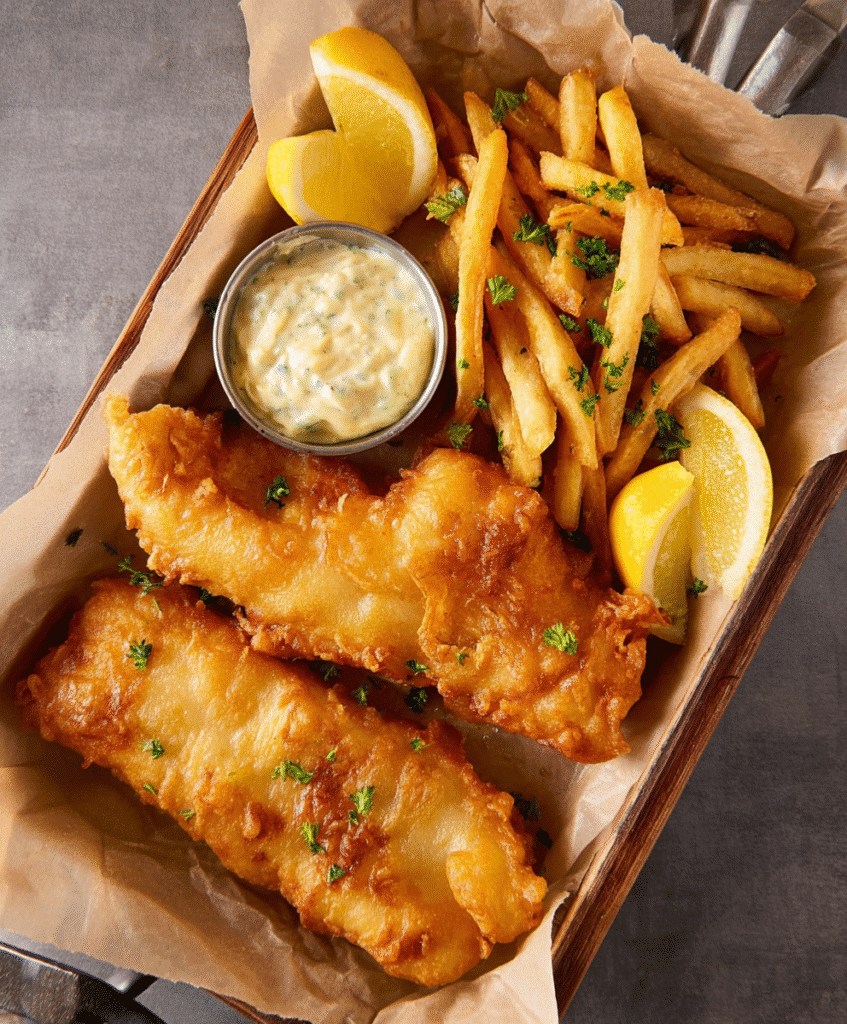
Tips for Success and Common Mistakes to Avoid
Keeping Your Batter Light and Crunchy
One of the most common questions when making gluten-free fish and chips is: How do I keep the batter light, not doughy? The answer? It’s all in the technique and the temperature.
First, don’t overmix your batter. Once the liquid hits the flour, stir just until combined. Overmixing kills the bubbles, leaving the coating heavy instead of crisp. Let the batter sit for 5 minutes before using—it allows the carbonation (from beer or club soda) to activate.
Keep the batter cold. Cold batter hitting hot oil causes an instant, crisp crust. If it sits out too long, chill it for a few minutes before dipping.
Also, make sure your oil stays at the right heat. If it drops below 350°F, the fish absorbs oil, making it soggy. Always bring the oil back to 375°F before frying your next batch.
When done right, gluten-free fish and chips turn out just as crunchy—if not better—than the traditional version.
Avoiding Soggy Chips and Overcooked Fish
There’s nothing worse than soggy fries or dry fish. Let’s fix that.
For the chips, always dry them thoroughly after soaking or boiling. Moisture on the surface turns to steam and ruins the fry. Use paper towels and don’t rush this step.
Par-frying is your secret weapon. The first fry cooks the inside. The second fry crisps the outside. Skipping this process means limp, pale chips.
For the fish, use a thermometer if needed. The sweet spot is an internal temp of 130°F–135°F. Pull the fish out once golden—don’t wait until it darkens too much or the inside will turn tough.
Avoid overcrowding the oil or air fryer basket. Doing so drops the temperature and creates uneven cooking. Space = crispness.
Gluten-free fish and chips may seem tricky at first, but once you master the technique, it becomes second nature—and way more rewarding than takeout.
Gluten-Free Fish Fry Storage and Reheating Tips
How to Store Leftovers Without Losing Crunch
Let’s be honest: gluten-free fish and chips is one of those meals that’s best eaten hot and fresh. But if you’ve made a big batch—or just couldn’t finish your plate—don’t worry. With the right storage techniques, your leftovers can still taste amazing the next day.
Separate the fish and chips. This is non-negotiable. Storing them together causes moisture transfer, turning everything limp. Place the fried fish in one airtight container and the chips in another.
Use paper towels. Line the bottom of each container with a layer of paper towels. This helps absorb any leftover oil and moisture, keeping the texture as intact as possible.
Cool before sealing. Let the food cool to room temperature before placing it in the fridge. Sealing warm food creates steam—which is the enemy of crunch.
Stored properly, your gluten-free fish and chips will keep in the fridge for up to 2 days. After that, the quality starts to drop off fast.
Best Reheating Methods for Fish and Chips
When you’re ready to enjoy those leftovers, skip the microwave. It turns crispy into chewy faster than you can blink.
Here’s how to reheat gluten-free fish and chips the right way:
For the Fish:
- Preheat your oven to 375°F
- Place the fish on a wire rack over a baking sheet
- Reheat for 10–12 minutes or until hot and crispy
Using a wire rack allows heat to circulate, crisping the bottom just as nicely as the top.
For the Chips:
- Set your oven to 400°F
- Spread chips in a single layer on a baking sheet
- Reheat for 8–10 minutes, shaking the tray halfway through
Want a faster method? The air fryer works wonders here too. Just set it to 375°F and cook the fish and chips for 5–7 minutes, checking for crispness.
Bonus idea: Repurpose leftover chips into breakfast hash or turn extra fish into gluten-free fish tacos!
You can even sandwich leftover fish inside our Gluten-Free Hamburger Buns for an easy next-day fish sandwich.

Nutritional Breakdown & Healthier Tweaks
Calories, Macros, and Nutrient Highlights
Let’s be real—gluten-free fish and chips isn’t diet food. But it can absolutely be part of a balanced lifestyle, especially when you know what’s going into it.
Here’s a general breakdown for one generous serving:
| Nutrient | Amount |
|---|---|
| Calories | ~650–700 kcal |
| Protein | ~45–50g |
| Carbs | ~90–105g |
| Fat | ~8–10g |
| Sodium | ~1000–1100mg |
| Fiber | ~6–8g |
The high protein content comes from the white fish, and you’ll also get potassium, omega-3 fatty acids, and B vitamins. The chips contribute most of the carbs, and the sodium can climb if you go heavy on seasoning.
What makes gluten-free fish and chips a solid comfort food choice is that it avoids the gut-triggering effects of wheat—making it safe for people with celiac disease or gluten sensitivity.
How to Make It Healthier Without Sacrificing Flavor
There are a few smart swaps and techniques that make gluten-free fish and chips lighter but still completely satisfying.
1. Use an Air Fryer:
Switching from deep-frying to air frying cuts the oil significantly. You still get the crunch, minus the heavy grease.
2. Go Light on the Batter:
Try brushing the batter on instead of dunking. You use less, but still lock in flavor and crispiness.
3. Sweet Potato Chips:
Swap traditional Russets for sweet potatoes. They’re rich in fiber, vitamins A and C, and provide a subtle sweetness that pairs well with savory fish.
4. Reduce Salt, Add Flavor:
Instead of loading on salt, add herbs and spices to both the batter and the chips. Smoked paprika, garlic powder, dill, or lemon zest can all enhance taste without increasing sodium.
5. Bake or Steam the Chips First:
Par-steam or roast the chips instead of frying both times. It reduces calories while keeping the inside fluffy and soft.
In the end, gluten-free fish and chips doesn’t need to be overly indulgent to hit the spot. A few smart tweaks can make it lighter and even more enjoyable.
For a balanced plate, pair lighter chips with a protein-rich main like our Instant Pot Crack Chicken Recipe—fast, filling, and gluten-free approved.
Conclusion
Gluten-free fish and chips proves that comfort food doesn’t need wheat to be crispy, golden, and unforgettable. Whether you’re frying in oil or going the air fryer route, this dish delivers big flavor with every bite—while still being safe for those with gluten sensitivities or celiac disease.
From picking the right fish to nailing the double-fry technique, you now have everything you need to master this pub-style classic at home. And the best part? It’s so good, even the non-gluten-free crowd won’t know the difference.
Follow us on Facebook & Pinterest for more gluten-free dessert ideas and community fun!
FAQ Section
Can fish and chips be gluten free?
Absolutely. Traditional fish and chips use wheat-based batter and shared fryers, but gluten-free fish and chips use certified gluten-free flour blends and safe cooking practices. With the right ingredients—like rice flour, gluten-free beer, and dedicated oil—you can enjoy all the crunch and flavor without the gluten.
How to make battered fish gluten free?
To make battered fish gluten free, use a mix of gluten-free flours (such as rice flour and a gluten-free flour blend) combined with baking powder, seasoning, and carbonated liquid like gluten-free beer or club soda. Dredge the fish first in dry rice flour to help the batter stick and fry until golden and crisp.
What fish fry is gluten free?
A gluten-free fish fry uses white fish like cod or haddock, coated in gluten-free batter and fried in uncontaminated oil. The key is ensuring all ingredients—from the flour to the seasoning—and even the fryer are 100% gluten free.
What is the best gluten free flour for coating fish?
Rice flour is one of the best options for coating fish. It’s naturally gluten free and creates a super light, crispy texture. You can also combine it with potato starch or a gluten-free all-purpose blend for extra crunch in gluten-free fish and chips.
